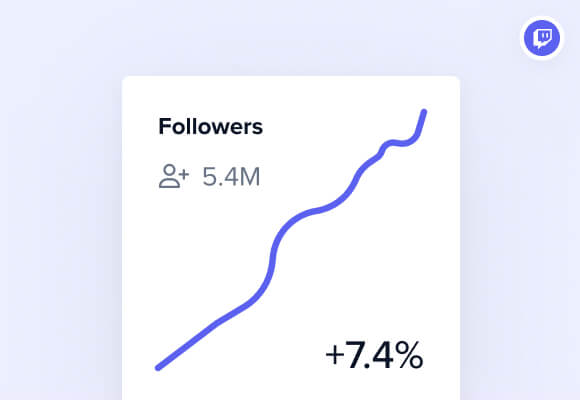Compare Twitch Channels
HypeAuditor is among the leading influencer marketing apps that helps brands and agencies to compare Twitch users, channels, and stats. With HypeAuditor’s Twitch Influencer Comparison Checker, you can compare Twitch stats like followers, follower growth, and average live views.
HypeAuditor’s Twitch Influencer Comparison Checker is a quick and easy comparison tool to compare Twitch subs, stats, and channels. You’ll be able to sort out Twitch influencers with small audiences, poor growth, minimal viewership, and low average live views. This free comparison tool helps you gain greater value from your Twitch collaborations while maximizing the effectiveness of your influencer marketing budget.
Compare Twitch Channels Questions
What does HypeAuditor’s Twitch Influencer Comparison Checker do?
HypeAuditor’s Twitch Influencer Comparison Checker allows you to compare two different streamers on Twitch and see how they measure with regards to their average live views, followers, and follower growth over the last month.
Why is it important to compare channels?
Comparing Twitch streamers and their performance is important to ensure that your influencer marketing budget is spent efficiently. It might even help you unlock a better deal.
For example, imagine two Twitch streamers have approximately the same numbers of followers, live views, and growth.
Streamer A wants $1,000 for a collaboration while Streamer B asks for $500. Assuming that Streamer A isn’t a celebrity who can bring in additional traffic purely on name recognition, why pay Streamer A when you can theoretically get two collaborations with Streamer B while enjoying similar results (times two since you’d be able to collaborate twice).
Why is it important to check follower counts?
For Twitch, follower count is purely a vanity metric. It provides no insight into live viewership, which is essential for a live streaming platform like Twitch. In fact, it’s possible to discover Twitch channels with over 300,000 followers who are unable to earn 1,000 live views. At one point during 2020, over 95% of all streams had viewership numbers that were less than a tenth of their follower count.
That being said, follower count does have its use as an initial filter. You can quickly eliminate channels that are too small with miniscule audiences, saving you time from vetting them.
Follower count also points you towards Twitch streamers with large audiences. Even if follower counts are a vanity metric, you’ll want to work with followers that have large numbers of followers since the more followers a streamer has, the more possible opportunities for sales you get.
There are some additional metrics that will help you narrow your influencer search when choosing a Twitch streamer.
Which metrics can I use for finding a Twitch streamer?
A good metric to start with is peak concurrent viewers. This metric reflects the highest number of viewers who were watching a certain stream at the same time. However, while it is good for illustrating how many viewers a Twitch streamer attached for a single stream, this metric is for a single moment in time. It doesn’t provide insight into how long a viewer stayed, as well as what viewership was like before or after this moment. Additionally, peak concurrent viewers can be easily skewed by Twitch giveaways as many viewers will tune in simply for the giveaway before dropping out.
Average concurrent viewership is another important metric. It’s often used to determine the cost of a Twitch streamer collaboration. It calculates the average number of viewers who watched the entire stream by taking samples of viewership at multiple points during the stream. But while it’s a useful metric of engagement, it has its drawbacks. The longer a stream is, the more the average concurrent viewership decreases.
Phrased differently, if a Twitch streamer has an average concurrent viewership of 100 for a one-hour stream, this means that the stream could have had 100 unique viewers who watched the stream for the full hour or 200 viewers who watched for 30 minutes.
You can also use viewer hours to inform your search for a Twitch streamer. It indicates how much of a stream was watched. However, it doesn’t provide full insight into engagement as it can’t distinguish between a small number of very engaged viewers versus a large number of barely engaged viewers.
Fortunately, if your goal is to drive clicks to your website, Twitch is arguably the ideal platform. Since clicks and conversions are trackable, you can easily track site visits during a Twitch collaboration and infer that any website traffic spikes are likely the result of your Twitch campaign. You can take Twitch collaborations one step further by providing Twitch streamers with unique codes or links that illustrate where website visitors originated from.
What are some “red flags” when looking for a streamer?
Considering the fact that Twitch is a live streaming platform, measuring performance is not as “simple” as it is for other social media platforms like Instagram or TikTok. However, there are still some red flags to be on the lookout for so that you make sure your marketing budget is well spent.
For example, if a Twitch channel consistently has a high peak concurrent viewership and a low average concurrent viewership, this is an indication that the channel is not effective at retaining audiences. It’s also possible that the channel may be inflating their peak concurrent viewership by running Twitch giveaways or conducting Twitch raids that attract a large number of viewers who then disappear once the “event” is over.
Another red flag is a Twitch channel’s audience health. If the average concurrent viewership and viewer hours are flat or dropping, it’s a sign that the Twitch channel is slowly losing its audience. While it might be an opportunity to strike a cheaper deal with a Twitch streamer, the risk of not recouping the initial investment is high.
One other red flag to watch for is the number of viewers for videos on demand. It can provide a rough indication of the type of content that may or may not be appealing to the streamer’s audience. For example, if a popular Twitch streamer plays an FPS game like Call of Duty most nights, then streams FIFA on Saturday evenings, if viewership plummets on Saturday evenings, then it’s a sign that you shouldn’t run any collaborations on Saturday with that particular influencer.












